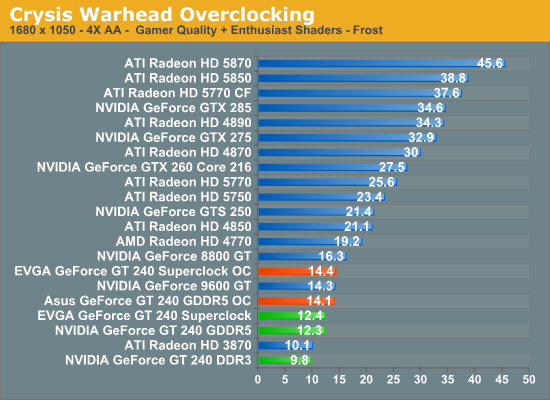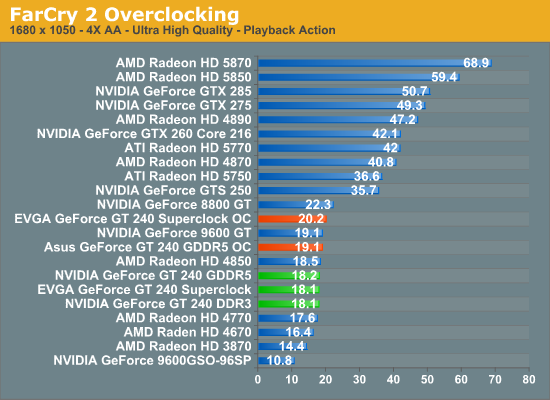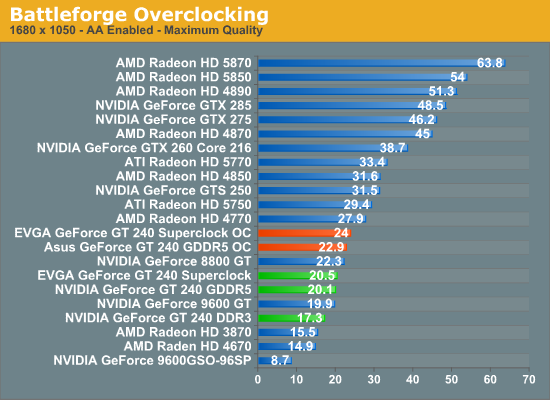NVIDIA’s GeForce GT 240: The Card That Doesn't Matter
by Ryan Smith on January 6, 2010 12:00 AM EST- Posted in
- GPUs
Overclocking
As we briefly mentioned in the introduction, the GT 240 has a 70W TDP, one we believe to be chosen specifically to get as much out of the card as possible without breaking the 75W limit of a PCIe slot. Based on the lower core and shader clock speeds of the GT 240 compared to the GT 220 (not to mention the 8800 GT) we believe it to be a reasonable assumption that the GPU is capable of a great deal more, so long as you’re willing to throw the 75W limit out the window.
There’s also the matter of the RAM. The DDR3 card is a lost cause anyhow thanks to its low performance and the fact that it’s only 10MHz below its RAM’s rated limit, but the GDDR5 cards have great potential. The Samsung chips on those cards are rated for 4000MHz effective, some 17% more than the stock speed of 3400MHz effective. If the memory bus can hold up, then that’s a freebie overclock.
So with that in mind, we took to overclocking our two GDDR5 cards: The Asus GT 240 512MB GDDR5, and the EVGA GT 240 512MB GDDR5 Superclocked.
For the Asus card, we managed to bring it to 640MHz core, 4000MHz RAM, and 1475MHz shader clock. This is an improvement of 16%, 17%, and 10% respectively. We believe that this card is actually capable of more, but we have encountered an interesting quirk with it.
When we attempt to define custom clock speeds on it, our watt meter shows the power usage of our test rig dropping by a few watts, which under normal circumstances doesn’t make any sense. We suspect that the voltage on the GPU core is being reduced when the card is overclocked, however there’s currently no way to read the GPU voltage of a GT 240, so we can’t confirm this. However it does fit all of our data, and makes even more sense once we look at the EVGA card.
For the EVGA card, we managed to bring it to 650MHz core, 4000MHz RAM, and 1700MHz shader clock. This is an improvement of 18%, 11%, and 27% respectively.
Compared to our Asus card, we do not get any anomalous power readings when attempting to overclock it, so if our GPU core voltage theory is correct, then this would explain why the two cards overclocked so differently. In any case, the significant shader overclocking should be quite beneficial in what shader-bound situations exist for the GT 240.

Crysis gives us some very interesting results when overclocked, and this data helps cement the idea that Crysis is ROP-bound on the GT 240. Compared to a stock GT 240, our overclocked Asus and EVGA cards get roughly 15% and 17% more performance. More interestingly, they’re only a few tenths of a frame apart, even though the EVGA card has its shaders clocked significantly higher.
As the performance difference almost perfectly matches the core overclock, this makes Crysis an excellent candidate for proving that the GT 240 can be ROP-bound. It’s a shame that the GT 240’s core doesn’t overclock more than the shaders, as given the ROP weakness we’d rather have more core clockspeed than shader clockspeed in our overclocking efforts.

When it comes to Far Cry 2, the significant shader speed differences finally make themselves more apparent. Our cards are still suffering from RAM limitations, but it’s still enough to get another 10% out of the EVGA card.

Finally with Battleforge we can see a full stratification of results. The overclocked EVGA card is some 19% faster than a stock GT 240, and 5% faster than the overclocked Asus. Meanwhile the Asus is 14% faster than stock, even with its more limited shader overclock.
Finally, on a quick note we’ll talk about power usage. As we mentioned previously only the EVGA card behaved correctly when overclocking – in overclocking that card we saw a 21W jump from 172W under load to 193W under load. If indeed that card is at or close to 70W under normal circumstances as NVIDIA’s specifications call for, then when overclocked it’s over 90W. It becomes readily apparent here that the clock speeds of the GT 240 were picked by NVIDIA to meet the PCIe power limit rather than the capabilities of the GPU itself.










55 Comments
View All Comments
MadMan007 - Wednesday, January 6, 2010 - link
Yup, iyo (in your opinion.) However it's clear from browsing just about any hardware forum for sale section that the used video card market is quite healthy. So if iyo it's a non-starter then you would be free to ignore such comparisons, but it's impossible for others to add such comparisons except by using indirect comparisons.Spoelie - Wednesday, January 6, 2010 - link
"That leaves the 4670, which the GT 240 beats."Except that you compared the GT240 to a 512MB 4670. You can get a 1GB 4670 for $75/$65 before/after rebate, or $70 without rebate.
The extra 512MB would bump up its performance and it still is a lot cheaper than a GT 240.
I can still find several 4770/4850 in stock, for now.
mczak - Wednesday, January 6, 2010 - link
The GT240 DDR3 doesn't beat the HD 4670 512MB if I look at these benchmarks, seems to be about a draw. The HD 4670 is significantly cheaper however. The 1GB HD 4670 are not going to be faster, in fact they are (at settings which are playable at least hence usually not limited by the amount of ram) slightly slower because they use a bit slower ddr3 memory instead of gddr3.The gddr5 version of the GT240 is faster than the HD 4670, I think it will be interesting to see how it'll fare against the HD 5670 (redwood based). If those early leaks are any indication, performance could be close, but I'd suspect the 5670 will draw less power, have more features (DX11, EyeFinity), and not be more expensive.
samspqr - Wednesday, January 6, 2010 - link
I wouldn't say the 240 beats the 4670: it is faster at high quality settings, where fps are unplayable with both cards; at quality settings that mean playable fps, they are kind of even, aren't they?Ryan Smith - Wednesday, January 6, 2010 - link
And just to reply to myself, the 5750 is still suffering from AMD's price inflation. At its MSRP it's worth a look, but at current prices it's in a different price bracket altogether.Zebo - Wednesday, January 6, 2010 - link
How can AMD price 5750 near it's MSRP when two smoke a 5850 and would be cheaper?Zebo - Wednesday, January 6, 2010 - link
MSRP of $109 and beats anything below $150, Thus it's repriced at ~140vol7ron - Wednesday, January 6, 2010 - link
Could you maybe explain why the 9800GT was not covered in the tests, but was talked about a lot on the intro. page?To me that makes no sense. "We'll tell you how the card compares physically, but we won't show you how it compares in practice."
Spacecomber - Wednesday, January 6, 2010 - link
I wondered the same thing. I believe that the 8800GT has the same specifications as the 9800GT; so, it will give you a pretty good idea of how the GT240 stacks up to the 9800GT.Ryan Smith - Wednesday, January 6, 2010 - link
Correct. We list an 8800 GT in our tests because that's the specific card we used, but 8800 GT == 9800 GT in specs and performance.